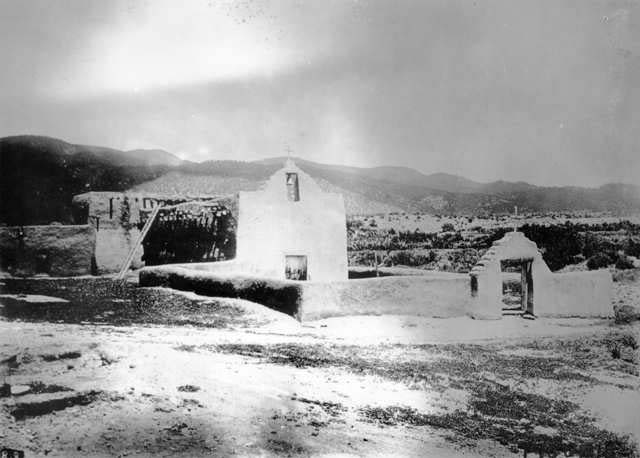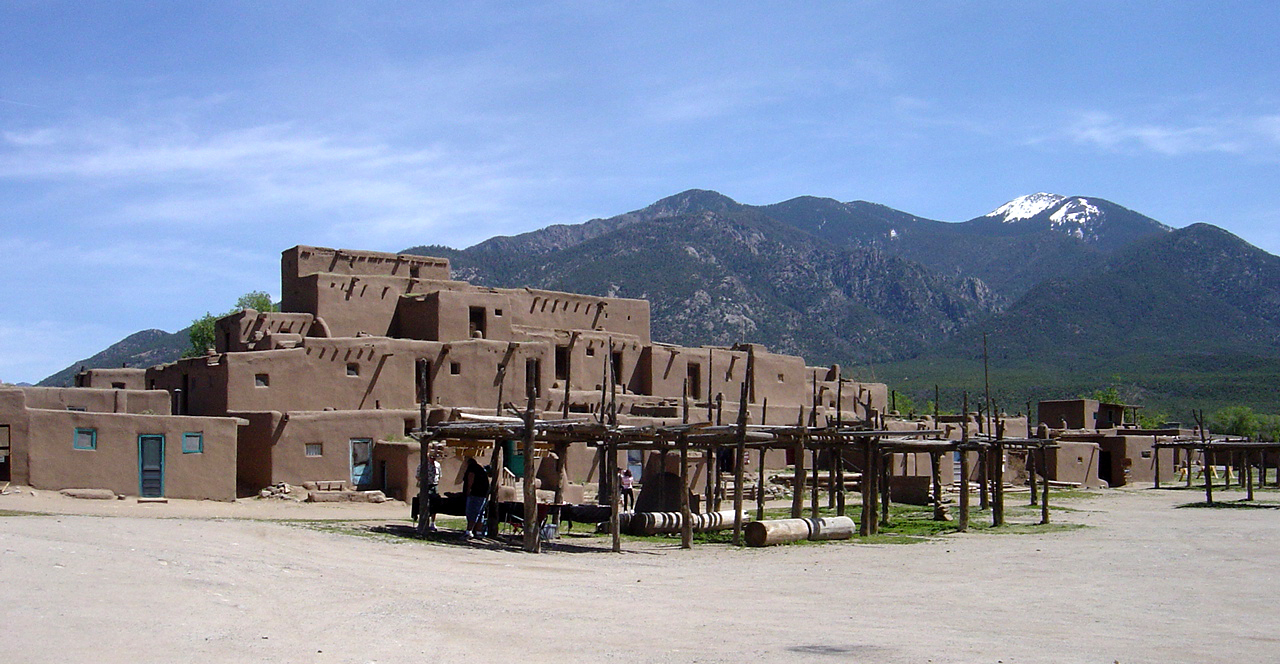|
Picuris
Picuris Pueblo (; Tiwa: P'įwweltha ’ī̃wːēltʰà is a historic pueblo in Taos County, New Mexico, United States. It is also a census-designated place (CDP) and a federally recognized tribe of Native American Pueblo people. The 2010 census estimated that 68 people lived in the CDP, while 267 people in the U.S. reported being of the tribal group Picuris alone and 439 reported being of the tribal group Picuris alone or in combination with other groups. Picurís Pueblo is a member of the Eight Northern Pueblos. Their own name for their pueblo is ''P'įwweltha'', meaning "mountain warrior place" or "mountain pass place." They speak the Picuris dialect of the Northern Tiwa language, part of the Kiowa-Tanoan language family. Geography Picuris Pueblo is located in northern New Mexico, on the western slopes of the Sangre de Cristo Mountains and 18 miles south of Taos Pueblo. Average elevation in the pueblo is over 7,000 feet.Pritzker, Barry M. ''A Native American Encyclopedia: His ... [...More Info...] [...Related Items...] OR: [Wikipedia] [Google] [Baidu] |
Picuris Language
Picuris (also Picurís) is a language of the Northern Tiwa branch of Tanoan spoken in Picuris Pueblo, New Mexico. Genealogical relations Picuris is partially mutually intelligible with Taos dialect, spoken at Taos Pueblo. It is slightly more distantly related to Southern Tiwa (spoken at Isleta Pueblo and Sandia Pueblo). Phonology : * The consonants are only found in recent Spanish loanwords. * G. Trager (1942, 1943) analyzed Picuris as also having aspirated stops , ejective stops , and labialized . These are considered by F. Trager (1971) to be sequences of , , and . * Velar has strong frication. * Stops are unaspirated while may be slightly aspirated. * The affricate freely varies with a more forward articulation : for example, F. Trager recorded the word "witch" with an initial but the related word "witch chief" with initial .F. Trager does not give further details about whether the forward articulation is dental or alveolar. If Picuris is like Taos, then the most ... [...More Info...] [...Related Items...] OR: [Wikipedia] [Google] [Baidu] |
Pueblo People
The Puebloans or Pueblo peoples, are Native Americans in the Southwestern United States who share common agricultural, material, and religious practices. Currently 100 pueblos are actively inhabited, among which Taos, San Ildefonso, Acoma, Zuni, and Hopi are the best-known. Pueblo people speak languages from four different language families, and each Pueblo is further divided culturally by kinship systems and agricultural practices, although all cultivate varieties of maize. Pueblo peoples have lived in the American Southwest for millennia and descend from Ancestral Pueblo peoples. The term ''Anasazi'' is sometimes used to refer to ancestral Pueblo people but it is now largely minimized. ''Anasazi'' is a Navajo word that means ''Ancient Ones'' or ''Ancient Enemy'', hence Pueblo peoples' rejection of it (see exonym). ''Pueblo'' is a Spanish term for "village." When Spaniards entered the area, beginning in the 16th-century with the founding of Nuevo México, they came acros ... [...More Info...] [...Related Items...] OR: [Wikipedia] [Google] [Baidu] |
Tanoan Language
Tanoan , also Kiowa–Tanoan or Tanoan–Kiowa, is a family of languages spoken by indigenous peoples in present-day New Mexico, Kansas, Oklahoma, and Texas. Most of the languages – Tiwa (Taos, Picuris, Southern Tiwa), Tewa, and Towa – are spoken in the Native American Pueblos of New Mexico (with one outlier in Arizona). These were the first languages collectively given the name of ''Tanoan.'' Kiowa, which is a related language, is now spoken mostly in southwestern Oklahoma. The Kiowa historically inhabited areas of modern-day Texas and Oklahoma. Languages The Tanoan language family has seven languages in four branches: Kiowa–Towa might form an intermediate branch, as might Tiwa–Tewa. Name Tanoan has long been recognized as a major family of Pueblo languages, consisting of Tiwa, Tewa, and Towa. The inclusion of Kiowa into the family was at first controversial given the cultural differences between those groups. The once-nomadic Kiowa people of the Plains are cu ... [...More Info...] [...Related Items...] OR: [Wikipedia] [Google] [Baidu] |
Tiwa Language
Tiwa (Spanish ''Tigua'', also ''E-nagh-magh'') is a group of two, possibly three, related Tanoan languages spoken by the Tiwa Pueblo, and possibly Piro Pueblo, in the U.S. state of New Mexico. Subfamily members and relations Southern Tiwa is spoken in by around 1,600 people in Isleta Pueblo, Sandia Pueblo, and Ysleta del Sur Pueblo (Tigua Pueblo). The remaining two languages form a subgrouping known as ''Northern Tiwa''. Northern Tiwa consists of Taos spoken by 800 people in Taos Pueblo and Picuris spoken by around 220 people in Picuris Pueblo. The extinct language of Piro Pueblo may also have been a Tiwan language, but this is uncertain (see Piro Pueblo language). History After the Pueblo Revolt against the Spanish conquistadors in 1680, some of the Tigua and Piro peoples fled south with the Spanish to El Paso del Norte (present-day Ciudad Juárez, Mexico). There they founded Ysleta del Sur, Texas; Socorro, Texas; and Senecú del Sur, Mexico. Their descendants continue ... [...More Info...] [...Related Items...] OR: [Wikipedia] [Google] [Baidu] |
Taos, New Mexico
Taos is a town in Taos County in the north-central region of New Mexico in the Sangre de Cristo Mountains. Initially founded in 1615, it was intermittently occupied until its formal establishment in 1795 by Nuevo México Governor Fernando Chacón to act as fortified plaza and trading outpost for the neighboring Native American Taos Pueblo (the town's namesake) and Hispano communities, including Ranchos de Taos, Cañon, Taos Canyon, Ranchitos, El Prado, and Arroyo Seco. The town was incorporated in 1934. As of the 2010 census, its population was 5,716. Taos is the county seat of Taos County. The English name ''Taos'' derives from the native Taos language meaning "(place of) red willows". Taos is the principal town of the Taos, NM, Micropolitan Statistical Area, which includes all of Taos County. History Taos Pueblo The Taos Pueblo, which borders the north boundary of the town of Taos, has been occupied for nearly a millennium. It is estimated that the pueblo was built ... [...More Info...] [...Related Items...] OR: [Wikipedia] [Google] [Baidu] |
Pueblo
In the Southwestern United States, Pueblo (capitalized) refers to the Native tribes of Puebloans having fixed-location communities with permanent buildings which also are called pueblos (lowercased). The Spanish explorers of northern New Spain used the term ''pueblo'' to refer to permanent indigenous towns they found in the region, mainly in New Mexico and parts of Arizona, in the former province of Nuevo México. This term continued to be used to describe the communities housed in apartment structures built of stone, adobe mud, and other local material. The structures were usually multi-storied buildings surrounding an open plaza, with rooms accessible only through ladders raised/lowered by the inhabitants, thus protecting them from break-ins and unwanted guests. Larger pueblos were occupied by hundreds to thousands of Puebloan people. Various federally recognized tribes have traditionally resided in pueblos of such design. Later Pueblo Deco and modern Pueblo Revival architectu ... [...More Info...] [...Related Items...] OR: [Wikipedia] [Google] [Baidu] |
Eight Northern Pueblos
The Eight Northern Pueblos of New Mexico are Taos, Picuris, Santa Clara, Ohkay Owingeh (formerly San Juan), San Ildefonso, Nambé, Pojoaque, and Tesuque. Taos and Picuris are Tiwa-speaking pueblos; the rest speak Tewa. Tiwa and Tewa are closely-related languages of the Tanoan language family. These pueblos make up the Eight Northern Indian Pueblos Council, which sponsors events and advocates for the legal interests of associated pueblos. The capital of the Eight Northern Pueblos is located in Ohkay Owingeh, New Mexico. Ohkay Owingeh was formerly known as San Juan, but reverted to its original Tewa name in 2005. See also * List of dwellings of Pueblo peoples Hundreds of Ancestral Puebloan dwellings are found across the American Southwest. With almost all constructed well before , these Puebloan towns and villages are located throughout the geography of the Southwest. Many of these dwellings inc ... References External links Indian Pueblo Cultural Center Website ... [...More Info...] [...Related Items...] OR: [Wikipedia] [Google] [Baidu] |
Taos County, New Mexico
Taos County is a county in the U.S. state of New Mexico. As of the 2010 census, the population was 32,937. Its county seat is Taos. The county was formed in 1852 as one of the original nine counties in New Mexico Territory. Taos County comprises the Taos, New Mexico Micropolitan Statistical Area. Geography According to the U.S. Census Bureau, the county has a total area of , of which is land and (0.06%) is water. The county's highest point is the summit of Wheeler Peak at 13,161 feet (4,011 m). This is also the highest natural point in New Mexico. The county has the highest mean elevation of any U.S. county outside of Colorado at , even though it ranks only 22nd overall. Taos County contains 17 of New Mexico's highest 25 peaks. Adjacent counties * Rio Arriba County - west * Mora County - southeast * Colfax County - east * Costilla County, Colorado - north * Conejos County, Colorado - northwest National protected area * Carson National Forest (part) * Rio Grande del N ... [...More Info...] [...Related Items...] OR: [Wikipedia] [Google] [Baidu] |
Federally Recognized Tribe
This is a list of federally recognized tribes in the contiguous United States of America. There are also federally recognized Alaska Native tribes. , 574 Indian tribes were legally recognized by the Bureau of Indian Affairs (BIA) of the United States.Federal Acknowledgment of the Pamunkey Indian Tribe Of these, 231 are located in Alaska. Description  In the United States, the Indian tribe is a fundamental unit, and the constitution grants
In the United States, the Indian tribe is a fundamental unit, and the constitution grants
|
Sangre De Cristo Mountains
) , country= United States , subdivision1_type= States , subdivision1= , parent= Rocky Mountains , geology= , orogeny= , area_mi2= 17193 , range_coordinates= , length_mi= 242 , length_orientation= north-south , width_mi= 120 , width_orientation= east-west , highest= Blanca Peak , elevation_ft= 14351 , coordinates= , highest_location= East of Alamosa, Colorado , map= , map_size= , map_caption= The Sangre de Cristo Mountains (Spanish for "Blood of Christ") are the southernmost subrange of the Rocky Mountains. They are located in southern Colorado and northern New Mexico in the United States. The mountains run from Poncha Pass in South-Central Colorado, trending southeast and south, ending at Glorieta Pass, southeast of Santa Fe, New Mexico. The mountains contain a number of fourteen thousand foot peaks in the Colorado portion, as well as all the peaks in New Mexico which are over twelve thousand feet. The name of the mountains may refer to the occasion ... [...More Info...] [...Related Items...] OR: [Wikipedia] [Google] [Baidu] |
Census-designated Place
A census-designated place (CDP) is a concentration of population defined by the United States Census Bureau for statistical purposes only. CDPs have been used in each decennial census since 1980 as the counterparts of incorporated places, such as self-governing cities, towns, and villages, for the purposes of gathering and correlating statistical data. CDPs are populated areas that generally include one officially designated but currently unincorporated community, for which the CDP is named, plus surrounding inhabited countryside of varying dimensions and, occasionally, other, smaller unincorporated communities as well. CDPs include small rural communities, edge cities, colonias located along the Mexico–United States border, and unincorporated resort and retirement communities and their environs. The boundaries of any CDP may change from decade to decade, and the Census Bureau may de-establish a CDP after a period of study, then re-establish it some decades later. Most unin ... [...More Info...] [...Related Items...] OR: [Wikipedia] [Google] [Baidu] |
Taos Pueblo
Taos Pueblo (or Pueblo de Taos) is an ancient pueblo belonging to a Taos-speaking (Tiwa) Native American tribe of Puebloan people. It lies about north of the modern city of Taos, New Mexico. The pueblos are considered to be one of the oldest continuously inhabited communities in the United States. This has been designated a UNESCO World Heritage Site. Taos Pueblo is a member of the Eight Northern Pueblos. Natives will almost never speak of their religious customs to outsiders, and, because their language has never been written down, much of the culture remains unknown to the rest of the world. A tribal land of is attached to the pueblo, and about 4,500 people live in this area. Setting The pueblo was constructed in a setting backed by the Taos Mountains of the Sangre de Cristo Range. The settlement was built on either side of Rio Pueblo de Taos, also called Rio Pueblo and Red Willow Creek, a small stream that flows through the middle of the pueblo compound. Its headwaters c ... [...More Info...] [...Related Items...] OR: [Wikipedia] [Google] [Baidu] |





